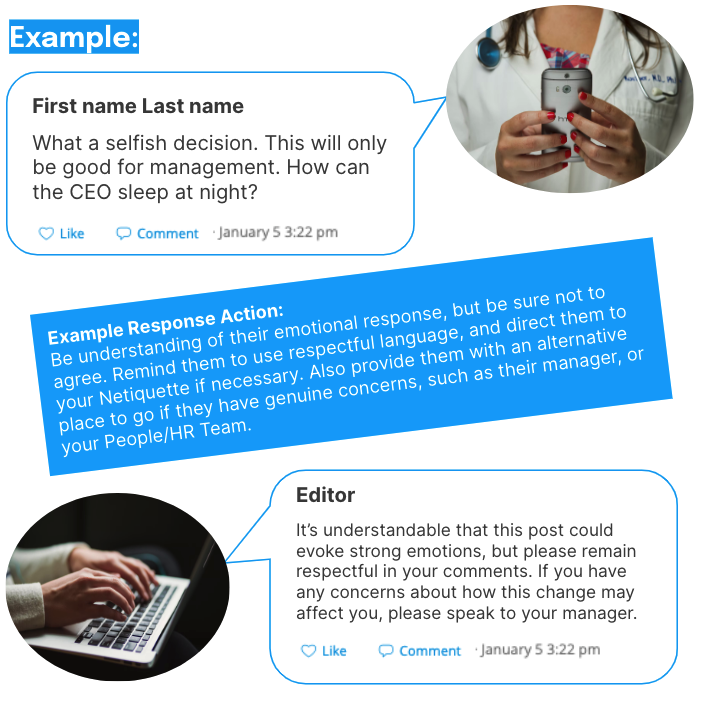As the internal communications landscape continues to develop and adapt, we’re thankfully seeing more two-way communications, allowing your employees to communicate with you — and each other — as well as just you communicating with them. But the engagement and interaction management of two-way communications can be daunting, especially if you haven’t opened them up before.
This article will explore two parts of two-way communications: sentiment analysis and interaction management.
What is engagement management?
As we see it, engagement management is:
Maintaining, monitoring, and analyzing interactions with published communications, such as reactions and comments, and user generated content (such as posts on social walls).
Why is it important? Engagement management is essential to keeping your platform a safe space for employees to express themselves, but it also helps you to understand how they’re feeling.
Who's in charge of engagement management?
Assigned “engagement managers”
These are the main people who will look after your engagement management; they will often be members of the internal communications team.
These people should be responsible for keeping an eye on comments, and decide when they need to be addressed.
Empowered line managers across the business
In an ideal world, your line managers should feel confident enough to respond to comments, either to answer questions or moderate where needed.
Sometimes, managers may not have the confidence to respond themselves. In the first instance, they should flag the comment to an engagement manager. However, it’s worth the investment to empower your line managers to be confident enough to take on this responsibility themselves.
Often the internal communications team or senior leaders will need line managers to communicate messages to employees, so training/guiding/supporting line managers to do this is a worthwhile investment.
Subject-matter experts who can answer people’s questions
When publishing an update or a change in process or policy requested by a team outside of internal communications, it’s a good idea to have a “subject-matter expert” on hand to answer employee questions that the comms team isn’t equipped to answer itself.
Self-assigned moderators
Sometimes you may find that your everyday employees feel inspired to join the conversation, especially if they disagree with negative comments others are leaving. Think of these people as the vigilantes of your intranet!
Any employee who wants to join the conversation
Of course, anyone who feels they want to take part in the conversation can do so. These people aren’t necessarily moderating comments or content, but they may have a question, leave words of encouragement, or tell you how they feel about something.

Sentiment analysis
Businesses are continuously trying to get a feel for how their customers view them: how they relate to the brand, whether they’d recommend their products, etc. But they often neglect to ask the same questions of their employees.
With employee turnover at an all-time high it’s now more important than ever to understand how your employees are feeling, and even more important to act on their feedback.
Sentiment analysis is all about looking at how your people are interacting and engaging with your content to help you understand how they’re feeling.
Where should I start?
- Use reactions, comments, and replies to get a holistic view into how your people are feeling. Are they commenting negatively on your content? Do they really like the new process announcement?
- Pulse surveys and deep dives should be used to ask employees specific questions about how they’re feeling.
- You can use the output from your analysis to help determine your communication strategy.
What is interaction management
As well as sentiment analysis, “interaction management” is a big part of engagement management. Specifically, interaction management means keeping an eye on interactions with your communications, such as reactions and comments, as well as user generated content.
Where should I start with interaction management?
- Collect all the rules of behavior and language style in your company Netiquette or Code of Conduct.
- Plan enough time to answer questions. Nothing is more frustrating than showing engagement but getting no response.
- Plan capacity of experts and managers if you know you’re about to publish sensitive or complex content.
- Enable your engagement managers.
How to manage interactions
There’s often a fine line between someone who is simply “blowing off steam” and behavior that is unacceptable and offensive.
You need to act when a comment has the potential to hurt, insult, or be damaging to business. It can be tough to know when to act, but these guidelines should be a useful aide.
When trying to assess cases, it can be helpful to refer to your existing Code of Conduct, and/or Netiquette.
Letting it run its course…
Not reacting to comments that breach your Code of Conduct or Netiquette can put your reputation at risk: the reputation of the app/intranet, your communication style, and potentially even the company.
It can also put off your friendly users if they feel the app/intranet isn’t a safe space. Once you lose their trust, it leaves the angry vocalists to themselves, and that could result in spiraling negative conversations.
Coming down too hard . . .
Immediately jumping on comments also has its risks. Simply deleting comments without providing justification or looking at other ways to deal with the situation can lead to accusations of censorship.
This can lead to people taking their thoughts off public forums and instead discussing them in private, allowing anger to build which may eventually express itself in public external forums.
How to respond
Justified critique
You can decide whether to respond to comments like these by monitoring the discussion.
When formulating your response, you should think about the following:
- Remain objective and neutral, and avoid expressing any other opinions (including your own!). As an editor, your role is moderate rather than to become part of the discussion.
- If the user has gone off topic, encourage them back to the original conversation so as not to alienate other readers.
- Remember that people sharing their opinions is a good thing, it shows they are engaged with your content! Where justified criticism is presented respectfully and isn’t offensive, remember to thank the employee for their contribution.
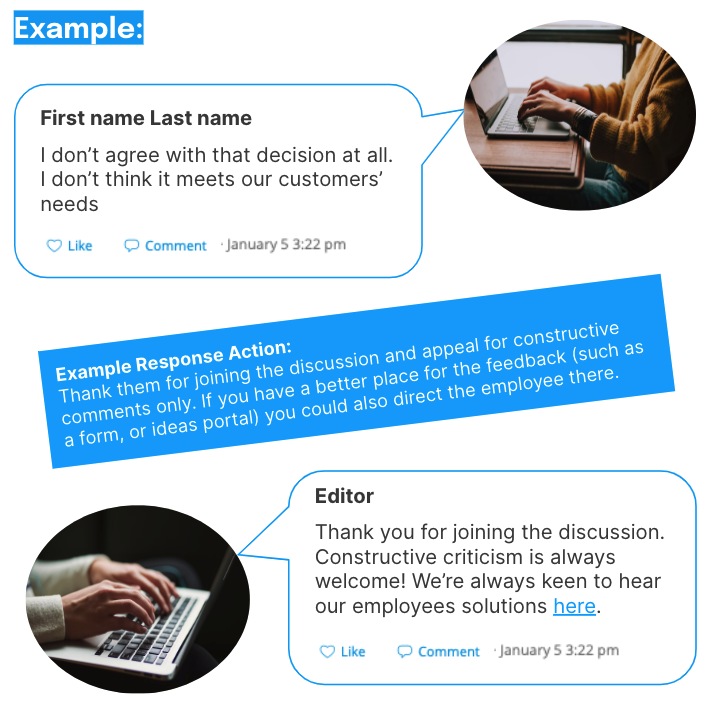
Harsh criticism
You can decide whether to respond to comments like these by monitoring the discussion.
When formulating your response, think about the following:
- Sometimes the tone of comments can become quite harsh. Make sure the article topic remains the main focus in the comments.
- Make sure people don’t get the impression that criticism isn’t welcome.
- Rather than addressing the user as an individual, ask that all contributors remain respectful of each other. This means the individual user is less likely to feel attacked, and also signals to other users that you support them.
- As before, keep your own opinions out of your response. Your neutral approach should hopefully keep a constructive conversation going.
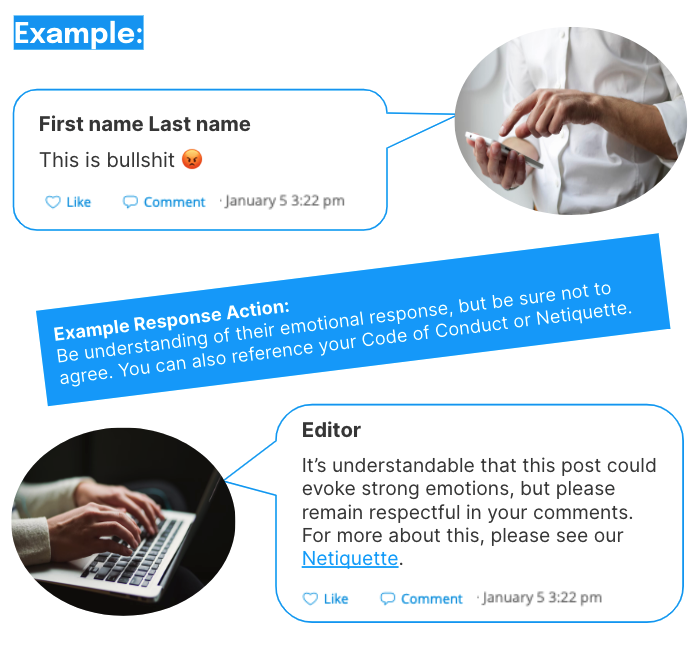
Insults (direct, or indirect)
You should respond to these comments.
When formulating your response, you should think about the following:
- Place the focus on mutual respect. As this is internal media, the user is not anonymous — they are a member of a team and an employee of the company. Make sure the author is aware of this.
- In some cases, authors may not be aware that their post could be insulting; sometimes a quick reminder is all you need. However, if the post is clearly designed to offend, or mentions specific users, it may be best to report the comment in line with your procedures.
- Remember to keep an eye on the thread. The last thing we want is an insult match. We need to avoid other users getting involved in a negative, and potentially offensive, conversation.
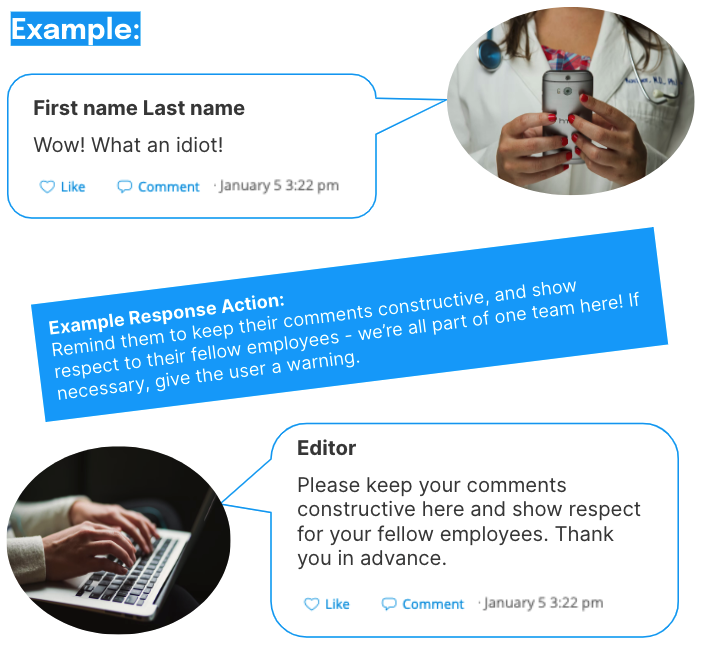
Incorrect information (fake news)
You should react to these comments to stop incorrect information from spreading.
When formulating your response, think about the following:
- Before you respond, make sure that the comment is definitely false information. If they have given a source, make sure you check that out.
- If the information shared is sensitive, it could be worth flagging the comment to senior stakeholders, and/or the People/HR Team.
- Remind the user that information like this can be worrying to their fellow employees, and appeal for respect.
- Depending on the content of the post, it may be necessary to report the comment. Remember: keep an eye on the thread to make sure other employees aren’t reacting negatively.
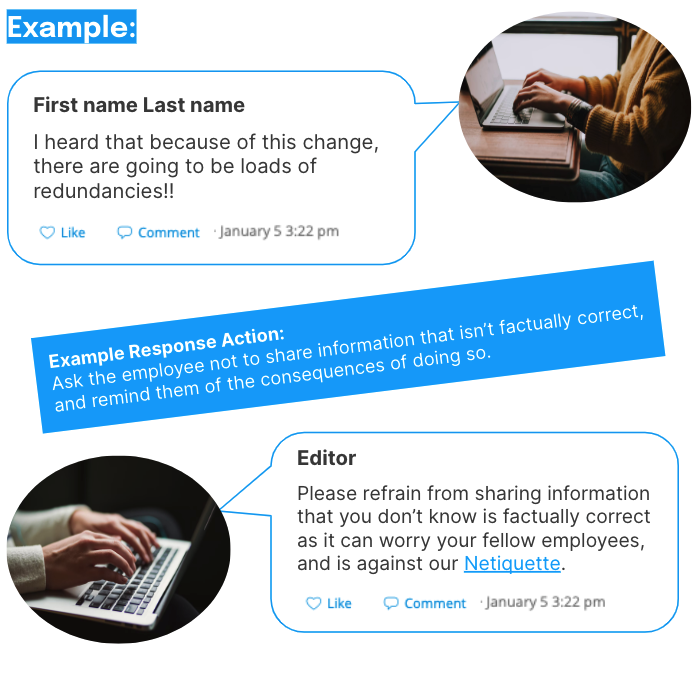
Emotive questions
You can decide whether to respond to comments like these by monitoring the discussion.
When formulating your response, think about the following:
- People sometimes feel safer expressing themselves with questions (although often rhetorical), rather than statements. Bear in mind that this is an emotional response.
- Emotional responses usually come quite instantly, but the user may cool off by themselves. Do direct them to someone who can hear and, if necessary, pass along their genuine concerns.
- Often, a user posting a question invites fellow users to respond. In milder cases, it can be useful for the author to hear the thoughts and responses of others to sway their thinking. In this instance, a response from an editor may not be necessary.
